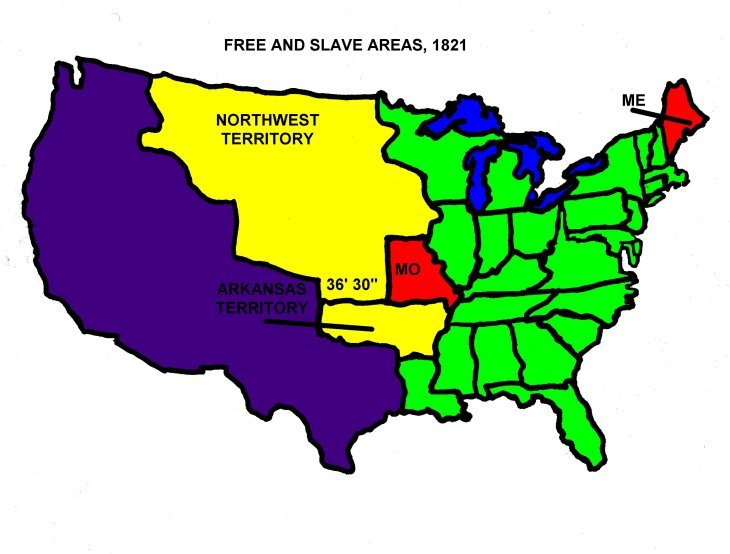
Topic: The Missouri Compromise

Topic: The Missouri Compromise
| Table of Contents | |
| Overview
Vocabulary Terms and Identifications Quiz |
Important
Maps
Biographies of Key Historical Figures Resources |
Overview:
When Missouri wanted to become
a state, it wanted to become a slave state. At the time when Missouri wanted
to become a state, there were eleven free states and slave states. When
the North had heard that Missouri might become a slave state, they were
angry because that meant that slave states would have more power in the
government. Therefore Representative James Tallmadge of New York proposed
the Tallmadge Amendment. The amendment said that every slave born child
in Missouri would be free after they would become twenty-five years of
age. The amendment also said that no slaves would be brought into Missouri.
The South did not agree this plan. The amendment was proposed in the House
of Representatives and it was passed. But when it was proposed in
the Senate, the Senate said no. While the people were still thinking about
what to do, Maine, that was a part of Massachusetts, asked to become part
of the Union as a free state. When Jesse B. Thomas of Illinois heard this,
he came up with a compromise that was called the Missouri Compromise. The
compromise said that Maine would become a slave state. It also stated that
slavery was banned from the Louisiana Purchase north of the 36* 30` except
in Missouri.
Vocabulary and Identifications
1) Union- Something formed by a combining of parts or members.
2) Compromise- Something formed by a combining of parts or members.
3) Slavery- People that are working without pay and with wearisome drudgery.
4) Louisiana Purchase- Land in the central area that was important in the Missouri Compromise.
5) Sectionalism- Devotion to the interests of one's own section over those of the nation as a whole.
Insert your maps in the table below with a caption or explanation.

Biographies
of Important People
| Henry
Clay
Henry Clay was the Speaker of the House in Congress. In 1820 to 1821, Clay was the one who engineered the Missouri Compromise and quieted the harsh issue that had erupted by keeping equal balance between free and slave states. When Jesse B. Thomas proposed his compromise, slavery extremists opposed any limits on the extension of slavery, but Henry Clay guided the measure through the house by a three vote majority. |
Jesse
B. Thomas
Jesse B. Thomas was a Senator of Illinois. He introduced a compromise by which slavery would be prohibited forever from Louisiana Purchase territories north of 36* 30`. |
1. Who was Henry Clay?
A: a smith
B: president of the U.S.
C: speaker of the House
2. What did Missouri do to break the balance of the U.S.?
A: wanted to be its own confederacy
B: applied to the Union
C: applied to the slave states
3. Who introduced a provision which slavery would be banned forever
from Louisiana Purchase territories of 36* 30`?
A: Henry Clay
B: Jesse B. Thomas
C: James Tallmadge
FILL IN THE BLANKS
4. Maine wanted to apply to be a(n) ______________________.
5. In 1820, Maine turned into a(n) _________________________ and Missouri turned into a(n) ______________________________.
MATCH THESE WORDS
6. Union _____
7. Compromise ______
8. Slavery ______
9. Louisiana Purchase _____
10. Sectionalism _____
A: Land in the central area that was important in the Missouri Compromise.
B: People that are working without pay and with wearisome drudgery.
C: Devotion to the interests of one's own section over those of
the nation as a whole.
D: Something formed by a combining of parts or members.
E: Settle of differences reached by mutual concessions.
ANSWERS
1. C
2. B
3. B
4. Free state
5. Free state, Slave state
6. D
7. E
8. B
9. A
10. C
Resources
Edward Pessen, Ph.D. 2000
http://encarta.msn.com
Bertram Wyatt-Brown 2000
http://encarta.msn.com
Encyclopedia (The New Book of Knowledge 1997) volume 12, Morris, Richard
This page is part of a web project developed by Mr. Cassutto's 7th grade US History class at Sterling Middle School
Student authors:
Patti H., Christine P., Micky S., and Ann F.
George Cassutto's Cyberlearning
World
[Lesson Plan of the Day] [Cassutto Memorial] [About the Author] [Search] [Civics Lesson Plans]